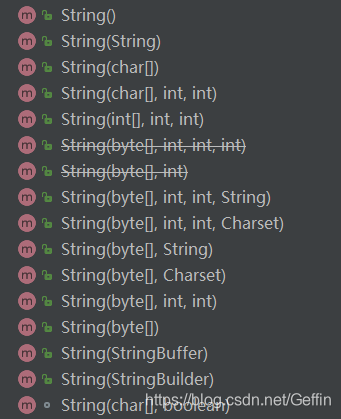String 详解
基于JDK1.8的String详解
String 类的定义
public final class String
implements java.io.Serializable, Comparable<String>, CharSequence {}
这是一个用 final 声明的常量类,不能被任何类所继承,而且一旦一个String对象被创建, 包含在这个对象中的字符序列是不可改变的, 包括该类后续的所有方法都是不能修改该对象的,直至该对象被销毁,这是我们需要特别注意的(该类的一些方法看似改变了字符串,其实内部都是创建一个新的字符串,下面讲解方法时会介绍)。接着实现了 Serializable接口,这是一个序列化标志接口,还实现了 Comparable 接口,用于比较两个字符串的大小(按顺序比较单个字符的ASCII码),后面会有具体方法实现;最后实现了 CharSequence 接口,表示是一个有序字符的集合,相应的方法后面也会介绍。
字段属性
/**用来存储字符串 */
private final char value[];
/** 缓存字符串的哈希码 */
private int hash; // Default to 0
/** 实现序列化的标识 */
private static final long serialVersionUID = -6849794470754667710L;
- 1
- 2
- 3
- 4
- 5
- 6
- 7
- 8
一个 String 字符串实际上是一个 char 数组。
构造方法
String 类的构造方法很多。可以通过初始化一个字符串,或者字符数组,或者字节数组等等来创建一个 String 对象。
String str1 = "abc";//注意这种字面量声明的区别,文末会详细介绍
String str2 = new String("abc");
String str3 = new String(new char[]{'a','b','c'});
- 1
- 2
- 3
equals(Object anObject) 方法
public boolean equals(Object anObject) {
if (this == anObject) {
return true;
}
if (anObject instanceof String) {
String anotherString = (String)anObject;
int n = value.length;
if (n == anotherString.value.length) {
char v1[] = value;
char v2[] = anotherString.value;
int i = 0;
while (n-- != 0) {
if (v1[i] != v2[i])
return false;
i++;
}
return true;
}
}
return false;
}
String 类重写了 equals 方法,比较的是组成字符串的每一个字符是否相同,如果都相同则返回true,否则返回false。
hashCode() 方法
public int hashCode() {
int h = hash;
if (h == 0 && value.length > 0) {
char val[] = value;
for (int i = 0; i < value.length; i++) {
h = 31 * h + val[i];
}
hash = h;
}
return h;
}
String 类的 hashCode 算法很简单,主要就是中间的 for 循环,计算公式如下:
s[0]*31^(n-1) + s[1]*31^(n-2) + ... + s[n-1]s 数组即源码中的 val 数组,也就是构成字符串的字符数组。这里有个数字 31 ,为什么选择31作为乘积因子,而且没有用一个常量来声明?主要原因有两个:
- 31是一个不大不小的质数,是作为 hashCode 乘子的优选质数之一。
- 31可以被 JVM 优化,31 * i = (i << 5) - i。因为移位运算比乘法运行更快更省性能。
charAt(int index) 方法
public char charAt(int index) {
//如果传入的索引大于字符串的长度或者小于0,直接抛出索引越界异常
if ((index < 0) || (index >= value.length)) {
throw new StringIndexOutOfBoundsException(index);
}
return value[index];//返回指定索引的单个字符
}
- 1
- 2
- 3
- 4
- 5
- 6
- 7
我们知道一个字符串是由一个字符数组组成,这个方法是通过传入的索引(数组下标),返回指定索引的单个字符。
compareTo(String anotherString) 和compareToIgnoreCase(String str) 方法
我们先看看 compareTo 方法:
public int compareTo(String anotherString) {
int len1 = value.length;
int len2 = anotherString.value.length;
int lim = Math.min(len1, len2);
char v1[] = value;
char v2[] = anotherString.value;
int k = 0;
while (k < lim) {
char c1 = v1[k];
char c2 = v2[k];
if (c1 != c2) {
return c1 - c2;
}
k++;
}
return len1 - len2;
}
- 1
- 2
- 3
- 4
- 5
- 6
- 7
- 8
- 9
- 10
- 11
- 12
- 13
- 14
- 15
- 16
- 17
- 18
源码也很好理解,该方法是按字母顺序比较两个字符串,是基于字符串中每个字符的 Unicode 值。当两个字符串某个位置的字符不同时,返回的是这一位置的字符 Unicode 值之差,当两个字符串都相同时,返回两个字符串长度之差。
compareToIgnoreCase() 方法在 compareTo 方法的基础上忽略大小写,我们知道大写字母是比小写字母的Unicode值小32的,底层实现是先都转换成大写比较,然后都转换成小写进行比较。
concat(String str) 方法
该方法是将指定的字符串连接到此字符串的末尾。
public String concat(String str) {
int otherLen = str.length();
if (otherLen == 0) {
return this;
}
int len = value.length;
char buf[] = Arrays.copyOf(value, len + otherLen);
str.getChars(buf, len);
return new String(buf, true);
}
- 1
- 2
- 3
- 4
- 5
- 6
- 7
- 8
- 9
- 10
首先判断要拼接的字符串长度是否为0,如果为0,则直接返回原字符串。如果不为0,则通过 Arrays 工具类的copyOf方法创建一个新的字符数组,长度为原字符串和要拼接的字符串之和,前面填充原字符串,后面为空。接着在通过 getChars 方法将要拼接的字符串放入新字符串后面为空的位置。
注意:返回值是 new String(buf, true),也就是重新通过 new 关键字创建了一个新的字符串,原字符串是不变的。这也是前面我们说的一旦一个String对象被创建, 包含在这个对象中的字符序列是不可改变的。
indexOf(int ch) 和 indexOf(int ch, int fromIndex) 方法
indexOf(int ch),参数 ch 其实是字符的 Unicode 值,这里也可以放单个字符(默认转成int),作用是返回指定字符第一次出现的此字符串中的索引。其内部是调用 indexOf(int ch, int fromIndex),只不过这里的 fromIndex =0 ,因为是从 0 开始搜索;而 indexOf(int ch, int fromIndex) 作用也是返回首次出现的此字符串内的索引,但是从指定索引处开始搜索。
public int indexOf(int ch) {
return indexOf(ch, 0);//从第一个字符开始搜索
}
- 1
- 2
- 3
public int indexOf(int ch, int fromIndex) {
final int max = value.length;//max等于字符的长度
if (fromIndex < 0) {//指定索引的位置如果小于0,默认从 0 开始搜索
fromIndex = 0;
} else if (fromIndex >= max) {
//如果指定索引值大于等于字符的长度(因为是数组,下标最多只能是max-1),直接返回-1
return -1;
}
if (ch < Character.MIN_SUPPLEMENTARY_CODE_POINT) {//一个char占用两个字节,如果ch小于2的16次方(65536),绝大多数字符都在此范围内
final char[] value = this.value;
for (int i = fromIndex; i < max; i++) {//for循环依次判断字符串每个字符是否和指定字符相等
if (value[i] == ch) {
return i;//存在相等的字符,返回第一次出现该字符的索引位置,并终止循环
}
}
return -1;//不存在相等的字符,则返回 -1
} else {//当字符大于 65536时,处理的少数情况,该方法会首先判断是否是有效字符,然后依次进行比较
return indexOfSupplementary(ch, fromIndex);
}
}
- 1
- 2
- 3
- 4
- 5
- 6
- 7
- 8
- 9
- 10
- 11
- 12
- 13
- 14
- 15
- 16
- 17
- 18
- 19
- 20
- 21
split(String regex) 和 split(String regex, int limit) 方法
split(String regex) 将该字符串拆分为给定正则表达式的匹配。split(String regex , int limit) 也是一样,不过对于 limit 的取值有三种情况:
1 limit > 0 ,则pattern(模式)应用n - 1 次
String str = "a,b,c";
String[] c1 = str.split(",", 2);
System.out.println(c1.length);//2
System.out.println(Arrays.toString(c1));//{"a","b,c"}
- 1
- 2
- 3
- 4
2 limit = 0 ,则pattern(模式)应用无限次并且省略末尾的空字串
String str2 = "a,b,c,,";
String[] c2 = str2.split(",", 0);
System.out.println(c2.length);//3
System.out.println(Arrays.toString(c2));//{"a","b","c"}
- 1
- 2
- 3
- 4
3 limit < 0 ,则pattern(模式)应用无限次
String str2 = "a,b,c,,";
String[] c2 = str2.split(",", -1);
System.out.println(c2.length);//5
System.out.println(Arrays.toString(c2));//{"a","b","c","",""}
- 1
- 2
- 3
- 4
下面我们看看底层的源码实现。对于 split(String regex) 没什么好说的,内部调用 split(regex, 0) 方法:
public String[] split(String regex) {
return split(regex, 0);
}
- 1
- 2
- 3
重点看 split(String regex, int limit) 的方法实现:
public String[] split(String regex, int limit) {
/* 1、单个字符,且不是".$|()[{^?*+\\"其中一个
* 2、两个字符,第一个是"\",第二个大小写字母或者数字
*/
char ch = 0;
if (((regex.value.length == 1 &&
".$|()[{^?*+\\".indexOf(ch = regex.charAt(0)) == -1) ||
(regex.length() == 2 &&
regex.charAt(0) == '\\' &&
(((ch = regex.charAt(1))-'0')|('9'-ch)) < 0 &&
((ch-'a')|('z'-ch)) < 0 &&
((ch-'A')|('Z'-ch)) < 0)) &&
(ch < Character.MIN_HIGH_SURROGATE ||
ch > Character.MAX_LOW_SURROGATE))
{
int off = 0;
int next = 0;
boolean limited = limit > 0;//大于0,limited==true,反之limited==false
ArrayList<String> list = new ArrayList<>();
while ((next = indexOf(ch, off)) != -1) {
//当参数limit<=0 或者 集合list的长度小于 limit-1
if (!limited || list.size() < limit - 1) {
list.add(substring(off, next));
off = next + 1;
} else {//判断最后一个list.size() == limit - 1
list.add(substring(off, value.length));
off = value.length;
break;
}
}
//如果没有一个能匹配的,返回一个新的字符串,内容和原来的一样
if (off == 0)
return new String[]{this};
// 当 limit<=0 时,limited==false,或者集合的长度 小于 limit是,截取添加剩下的字符串
if (!limited || list.size() < limit)
list.add(substring(off, value.length));
// 当 limit == 0 时,如果末尾添加的元素为空(长度为0),则集合长度不断减1,直到末尾不为空
int resultSize 



